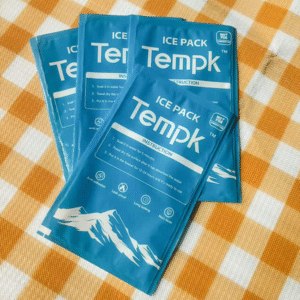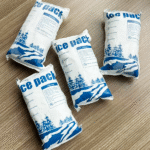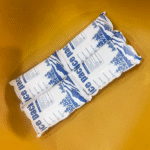Lieferung von Trockeneisbeuteln: So gewährleisten Sie einen sicheren und effizienten Versand?
Der Versand temperaturempfindlicher Güter erfordert eine zuverlässige Kühllösung, Und Trockeneisbeutel are a top choice. These packs ensure your products stay frozen during transit, ihre Qualität und Integrität bewahren. Egal, ob Sie verderbliche Lebensmittel versenden, medizinische Versorgung, oder Pharmazeutika, understanding the proper use of dry ice is crucial for efficient and safe delivery. This guide will walk you through everything you need to know to ensure your dry ice shipping process is seamless and compliant with industry standards.
-
Was sind Trockeneisbeutel Und wie funktionieren sie??
-
Wie wählen Sie den richtigen Trockeneisbeutel für Ihre Sendung aus??
-
What safety measures should you follow when shipping with dry ice?
-
How can you ensure dry ice effectiveness during delivery?
Was sind trockene Eisbeutel und wie funktionieren sie??
Trockeneisbeutel sind verfestigtes Kohlendioxid (Co₂) that sublimates at a temperature of -78.5°C (-109.3° F). Im Gegensatz zu normalem Eis, dry ice doesn’t melt into liquid but transforms directly into gas, making it ideal for shipping temperature-sensitive goods without creating water damage. This property makes dry ice particularly useful for perishable items, Arzneimittel, Biologische Proben, and food products that need to stay frozen or chilled during transit.
Dry ice packs are also favored for their ability to maintain temperatures without leaking liquid, providing a dry, mess-free solution for your shipments. Whether you are transporting vaccines or frozen seafood, using the right dry ice pack ensures that your goods remain in their optimal condition.
Characteristics of Dry Ice
| Merkmal | Beschreibung | Was es für Sie bedeutet |
|---|---|---|
| Temperatur | Sublimiert bei -78,5 °C | Keeps items frozen during transit |
| Sublimationsrate | 5-10 Pfund pro Stück 24 Std. | Helps you determine when to replace packs |
| Vorschriften | Subject to DOT & Hier sind Regeln | Ensures compliance and avoids legal issues |
How Do You Select the Right Dry Ice Pack for Shipping?
Choosing the right dry ice pack is essential for maintaining the correct temperature throughout the shipping process. Berücksichtigen Sie die folgenden Faktoren:
1. Product Type and Temperature Sensitivity
Einige Artikel, wie Impfstoffe, require extended freezing periods, while others, like food products, may need only short-term cooling. Understanding your product’s specific temperature needs will help you select the appropriate dry ice pack.
2. Versanddauer
Für längere Sendungen, you may need larger or multiple dry ice packs. Zum Beispiel, a short 24-hour shipment may only require a small amount, while longer shipments may need 10-20 lbs of dry ice to maintain the necessary temperatures.
3. Size of the Shipping Container
Ensure the dry ice fits within the container without jeopardizing the integrity of the product. Too much dry ice can cause unnecessary pressure buildup, while too little may not effectively maintain the cold chain.
Best Practices for Ensuring Dry Ice Effectiveness During Delivery
Verwenden Sie isolierte Verpackungen
To maximize the longevity of dry ice, always package your goods in insulated containers. This helps slow down the sublimation process and ensures the dry ice lasts for the entire shipping period.
Monitor Temperature with Sensors
Many shipping services offer temperature sensors, which can help track the effectiveness of dry ice during transit. These sensors alert you if the temperature falls outside the acceptable range, ensuring that the shipment stays within the required temperature window.
Wählen Sie die richtige Größe
Bigger isn’t always better. The size of the dry ice pack should match the shipment’s duration and the temperature sensitivity of the goods. Avoid over-packing, as this could lead to excessive sublimation and unnecessary waste.
Fallstudie:
A pharmaceutical company recently upgraded their shipping practices by using dry ice packs for global deliveries. Infolge, they reduced product spoilage by 40%, ensuring that vital medical supplies arrived in perfect condition.
How to Safely Handle and Store Dry Ice
Handling dry ice requires precautions due to its extremely low temperatures and potential health hazards.
Key Safety Measures for Using Dry Ice:
-
Ordnungsgemäße Belüftung: Always store dry ice in well-ventilated areas to prevent the buildup of CO₂ gas, which can displace oxygen in confined spaces and cause suffocation.
-
Schutzausrüstung: Always wear insulated gloves and goggles when handling dry ice to avoid frostbite and eye injuries.
-
Entsorgung: Allow dry ice to sublimate in an open outdoor area. Never dispose of it in small or enclosed spaces.
| Safety Guideline | Aktion | Warum ist es wichtig |
|---|---|---|
| Belüftung | Store in areas with good airflow | Prevent CO₂ buildup and suffocation |
| Schutzausrüstung | Verwenden Sie Handschuhe und Schutzbrille | Avoid frostbite and injuries |
| Entsorgung | Let it sublimate in open air | Prevent hazardous buildup in closed spaces |
2025 Trends und Entwicklungen in der Trockeneisschifffahrt
The world of dry ice shipping is rapidly evolving, with new trends and technologies improving efficiency, Sicherheit, und Nachhaltigkeit.
Neue Trends in der Trockeneisschifffahrt:
-
Intelligente Überwachungssysteme: Real-time temperature tracking systems are becoming more prevalent, alerting users if the shipment’s temperature falls outside the acceptable range.
-
Blockchain for Cold Chain: The use of blockchain ensures greater transparency and traceability in dry ice shipping, particularly for high-value pharmaceutical shipments.
-
Umweltfreundliche Isolierung: Companies are developing more sustainable packaging materials that reduce the amount of dry ice required, contributing to both cost savings and environmental benefits.
Markteinsichten: Cold Chain Logistics in 2025
With the global demand for cold chain logistics rising, the market for dry ice solutions is expected to grow significantly. Von 2025, Der Markt wird voraussichtlich erreichen $500 Milliarde, driven by increasing demand for fresh food, Biologika, und andere temperaturempfindliche Produkte.
Häufig gestellte Fragen
Q1: Wie lange wird das Eis während des Versands trocknen??
Trockeneis dauert normalerweise dazwischen 24 Und 48 Std., je nach Größe und Isolierung. Larger packs last longer, while smaller ones are better for shorter shipping times.
Q2: Kann ich Trockeneis international versenden??
Ja, Trockeneis kann international versendet werden, but it must comply with specific regulations such as Iata guidelines for air transport and PUNKT regulations for ground shipping.
Q3: Wie berechne ich, wie viel Trockeneis ich brauche?
Calculate the amount of dry ice based on the shipment size, Dauer, and insulation type. Eine allgemeine Richtlinie ist 5-10 lbs von Trockeneis pro 24 Std. Versand.
Schlussfolgerung und Empfehlungen
Dry ice packs are indispensable for shipping perishable goods and ensuring product quality during transit. Indem Sie Best Practices befolgen, selecting the right pack, und Einhaltung der Sicherheitsvorschriften, you can confidently ship temperature-sensitive products without worrying about spoilage.
Nächste Schritte:
-
Bewerten Sie Ihre Versandanforderungen: Bestimmen Sie die Temperaturanforderungen und die Versanddauer Ihres Produkts.
-
Educate Your Team: Ensure your team is trained in the safe handling of dry ice.
-
Monitor Technological Advancements: Stay updated on new technologies to improve efficiency and reduce waste.
Über Tempk
Bei Tempk, we provide high-quality dry ice solutions designed to meet the needs of various industries. With years of experience in cold chain logistics, our dry ice packs ensure your goods remain safe and cold, Egal die Entfernung. Let us help you streamline your shipping process!
For more information on our dry ice shipping solutions, Kontaktieren Sie uns noch heute!
























